![]()
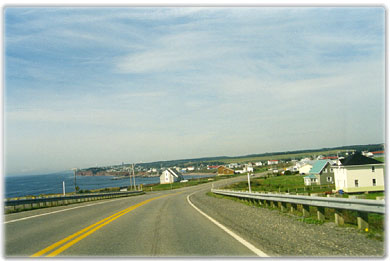 As
we rounded the southeastern bend, the Gaspé peninsula took on yet
another personality. Jim, our golfing partner, had mentioned how the regions
of Gaspé were very different from one another, and he was right. Along
the southern coast, the terrain was flatter, we saw more sandy beaches,
and the climate was warmer.
As
we rounded the southeastern bend, the Gaspé peninsula took on yet
another personality. Jim, our golfing partner, had mentioned how the regions
of Gaspé were very different from one another, and he was right. Along
the southern coast, the terrain was flatter, we saw more sandy beaches,
and the climate was warmer.
Also, there
seemed to be more homes and slightly larger towns — though everything
is relative. We're still talking about populations around 4000 at the
most.
 But
there were still many things in common with other parts of Gaspé.
Two of note: lighthouses and churches. Here's a typical Gaspésian
Catholic church, this one was in Grande-Rivière. As I mentioned earlier,
they are usually massive, stone and have one or two metallic spires.
But
there were still many things in common with other parts of Gaspé.
Two of note: lighthouses and churches. Here's a typical Gaspésian
Catholic church, this one was in Grande-Rivière. As I mentioned earlier,
they are usually massive, stone and have one or two metallic spires.
Oh yes,
something else we saw and this was everywhere we went in Québec:
many private homes and businesses had large 2000
numerals or signs hung prominently. They must have had some celebration
this past New Year's Eve as most of these were formed with lights —
the whole province could probably have been seen from space at night.
(See Southern Gaspé slide show.)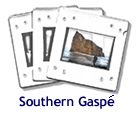
Port-Daniel
was located around a pretty bay. We drove out a side road along its western
shore and saw several newer, more modern homes — they were notable
only because of the contrast to the older, smaller homes we'd seen almost
everywhere else in Gaspé. They had a nice location high above the
water.

Looking
east across Baie de Port-Daniel
At St-Godefroi, we stopped at a red sand beach with some interesting breakwaters (?) and looked back on the cliffs in Shigawake (in slide show).
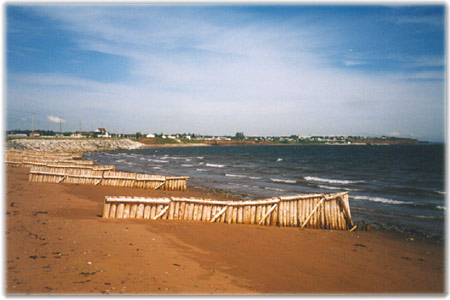
One thing
we had been missing on the trip (and craving) was wildlife. Yes, we'd
seen the dolphins, seals, and birds in Percé, but where were all the
landlubbers? The moose and caribou the region is home to? Well, I was
ready to cheat at this point. It was our last day in Gaspé, and since
the animals hadn't come to us ... I'd read about a Bioparc in Bonaventure,
a place where they had created a condensed version of Gaspésian plant
and animal life in five ecosystems: bay, lagoon, forest, tundra, river.
Sounded good
to us.
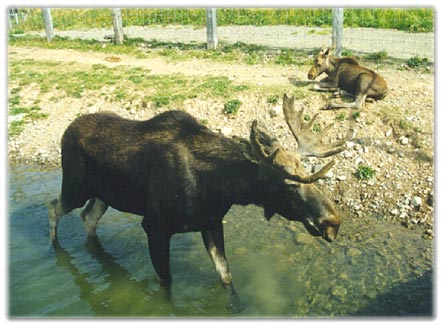
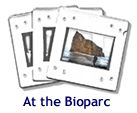 We
had the park to ourselves (we've been awfully lucky and spoiled on most
of our trips in this regard) and made the trek around the different regions.
Pretty nice settings for the animals, and we got our fix. (See
Bioparc slide show.)
We
had the park to ourselves (we've been awfully lucky and spoiled on most
of our trips in this regard) and made the trek around the different regions.
Pretty nice settings for the animals, and we got our fix. (See
Bioparc slide show.)
Afterwards, we were hungry and it was getting sweaty hot for the first time since we'd been in Gaspé. We soon found a cute ice cream parlour/drug store right on the Baie des Chaleurs (bay of warm waters) and refueled and cooled. New Brunswick mountains and hills were very clear across the bay ... we were on our way to the junction.
It was more mountainous around New Richmond and Carleton — by the way, the Gaspé peninsula is the eastern end of the Appalachian Mountain chain. We didn't "do" this area properly, unfortunately. Our time was running out and we had to keep moving. We crossed over to New Brunswick at Pointe-a-la-Croix, so didn't get to the Matapédia region. (Question: is it human nature or just my nature to focus on what we missed seeing and doing, the shots that I should have taken, etc.?)
It was a long trek across New Brunswick in the rain, but we finally got to the rickety, narrow bridge that took us across the St. John River and over the border to Van Buren, Maine. It's always with a sense of relief that we return to the US. As much as I love Canada, it's neat to feel that way coming home.
Galleries
...
Québec — Gaspésie
— Percé 1 — Percé
2 — Percé 3
© 2001 CCarnovale Home | Web Design | Graphics | Photos | Travels | At Home
